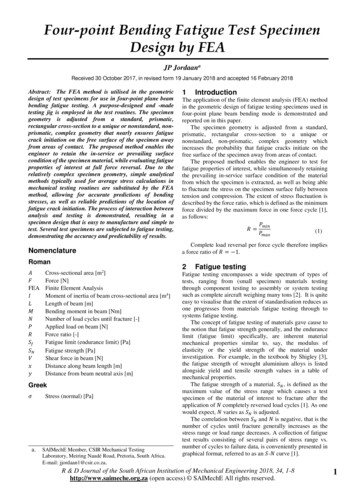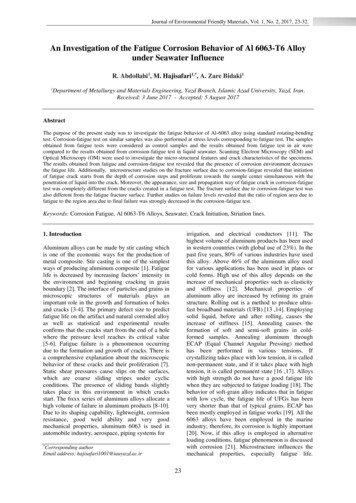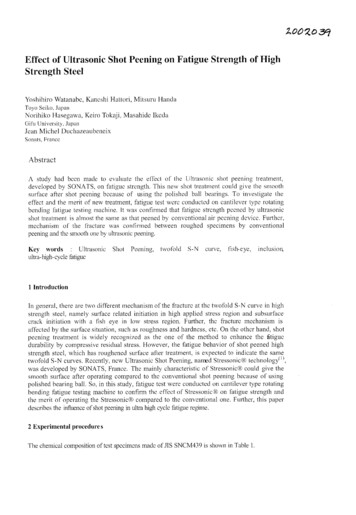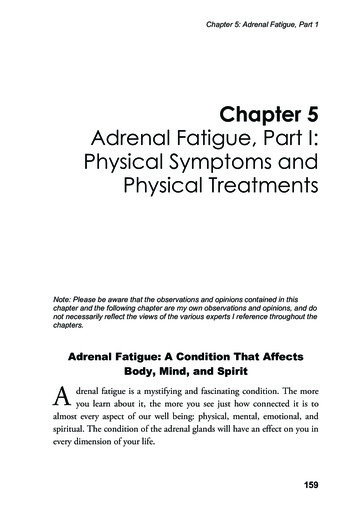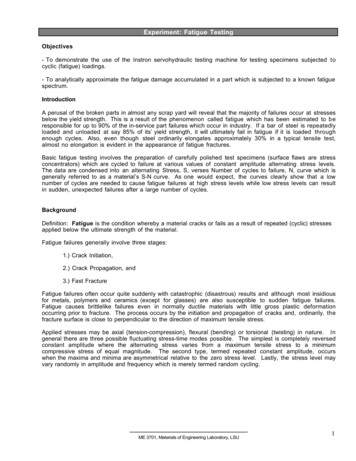
Transcription
Lab Based Treatments for Fatigue and DepressionMeasuring Mitochondrial FunctionDaniel Kalish, DC, IFMCPFounder Kalish Institute
Lahnor Powell, ND, MPHMedical Education Specialist - Atlanta
Daniel Kalish, DC, IFMCPLead faculty for IFMs Practice Implementation ProgramPrinciple investigator in research study with Mayo Clinic on The Kalish MethodPartnering with industry leading experts developing curriculum for lab interpretation skills developmentIFM Certified practitioner 28 years clinical experience
Need More Resources?ExploreWWW.GDX.NETfor more information andeducational resources, including GDX – Brief video modulesLIVE GDX – Previous webinar recordingsGI University – Focused learning modulesLEARNMYGDX – Order materials and get results
Lab Based Treatments for Fatigue and DepressionMeasuring Mitochondrial FunctionDaniel Kalish, DC, IFMCP
Objectives for This Presentation Learn meaning of high and low mitochondrial markers on organic acids Understand role of oxidative stress, toxins, nutrient depletion and medicationinduced depletion in mitochondrial damage Review most commonly used supplement programs to restore healthymitochondrial energy production
Who Do We Use Organic Acids Testingand ION Panels With?EVERYONE Complex patients Simple patients Annual health assessment for long term maintenance Prenatal nutritional programs Chemotherapy and radiation recovery programs Weight loss Fatigue Depression/anxiety
Organic AcidsOrganic acid testing checks mitochondrial functionOrganic acid testing measures detoxification capacity(toxin build up mito damage)Also measures oxidative stress markers(high oxidative stress mito damage)
Many Patient Presentations From Mitochondrial IssuesOverweightpatientToxic patientChronicfatigue patientCardiovascularissues patientDepressionissues patient
Chronically Ill Patients The more complicated a patient is, the more the basics become essential Most chronically ill patients have major metabolic imbalances May not be respond to treatment because the underlying metabolic issuesare still present, even though the proximate immediate issue has beenresolved
Essential to Life – Mitochondria – Why we Breathe Mitochondria consumes about 90% of theoxygen used by the body for oxidativephosphorylation Oxygen serves as the ultimate electron receptorfrom the electron transport chain, allowing ATPto be generatedPhoto Credit: es/causes-inheritance
Mitochondrial Marker Patterns Most organic acids are intermediates or end stage metabolism of energyproduction High levels of intermediates indicates nutrient deficiencies Key nutrients include CoQ10, Magnesium, Carnitine, B Vitamins
How Mitochondria Damaged Our Toxic World Nearly 80,000 new synthetic chemicals have been released into the environmentOver 350 different pesticides are used on the food we eatNewborn babies typically contain 50-70 dangerous toxins at birthIn the U.S. alone, over 4 billion pounds of pesticides are used every yearThere are at least 5,000 chemical ingredients in cosmeticsDEPLETION OF MAGNESIUM, GLUTATHIONE, RUINATION OF DETOX PATHWAYSAND BUILD UP OF OXIDATIVE STRESS CONTRIBUTE TO MITOCHONDRIAL DAMAGE
Photo Credit: 06/Liver-detoxification
Oxidative Stress Free radicals cause severe damage to the normal cells of the body, which canmanifest into diseases such as heart disease and cancer DNA damage is induced by oxidative stress Inflammation and free radical activity go hand in hand Excessive oxidative stress can cause liver damage Oxidation markers don’t tell you where the oxidation is coming from, but morehow the person is handling the oxidative stress
Oxidative StressPhoto Credit: mitochondria-fix-your-brain
Mitochondrial Retracted States Mitochondrial retraction is defined here as sustained reduction in the numbermitochondrial functional units per cell to compensate for chronically reducedlevels of enzymes and cofactors necessary to complete the transfer of electrons tooxygen, thereby allowing cell survival under conditions of oxidative stress
Hypometabolic Patterns High levels of intermediates is typically trouble Low levels mean there are not enough amino acids, which means there are notenough components to convert into metabolites Patients are tired with:- High levels of organic acid markers- Even more tired and depressed when levels are extraordinarily low- Thyroid often involved also as are amino acids
Major Depression, Chronic Fatigue Syndrome Chronic Compensatory States (Mitochondrial-Retracted) Reversed by ffAA mTOR Activation Low Organic Acids markers CAN be reversed by stimulating mTOR, this is differentthan using amino acids for low amino acids on a test We can use the same supplement to replace something missing or for stimulationof a specific process pathway or cell signaling system
mTOR Mammalian target of rapamycin and/or mechanistic target of rapamycin Discovery began in 1960’s on EASTER ISLAND (Rapa Nui)– I’m not making this up! Integrates input from upstream pathways INSULIN, growth factors and AMINOACIDS Central regulator of mammalian metabolism Inhibited by rapamycin, stimulated by large bolus of ffAA
Tissue Regulation by Mechanistic Target of RapamycinHere we find the mechanistic explanation of major depressionand CFS response to free-form amino acidsMembranekinasesGlycogensynthesis
Amino Acids To Organic AcidsAMINO ACIDS TURN INTO epatic TDOHepatic TransaminasesBrain IDOB6FolateProducts in Overnight Fatty acidsKynurenatePicolinateB1, B2, roxymethylglutarateCholesterolSerotoninNAD
Early evidence of free-form amino acid corrections1994 - Chronic Fatigue Syndrome
Early evidence of free-form amino acid corrections2007 – Major depression subjects on Remeron48.0%-30.6%17.4 % greater or 57 % Placebo
How Hypometabolic States Get Started Tryptophan depletion enhanced by SSRI therapyLow glutathione, low magnesium, low CoQ10Toxin exposure, oxidative stress load highGI issues poor protein absorption, low amino acids
Tryptophan depletion is enhanced by SSRI therapy TD was significantly related to increased scores on clinician-rated depression and anxiety scales,and on self-rated depression, anxiety, and somatic symptoms– Spillmann MK, et al. Tryptophan depletion in SSRI-recovered depressed outpatients. Psychopharmacology.2001;155(2):123-127. Significant increase of anxiety– Argyropoulos SV, at al. Tryptophan depletion reverses the therapeutic effect of selective serotoninreuptake inhibitors in social anxiety disorder. Biol Psychiatry. 2004;56(7):503-509. TD: significant decrease in perceived control and increase in interfering thoughts– Hood SD, et al. Effects of tryptophan depletion on selective serotonin reuptake inhibitor-remitted patientswith obsessive compulsive disorder. J Psychopharmacol. 2017;31(12):1615-1623. Conclusion: Compensatory responses to the diet restriction commonly seen in depression and CFSare accelerated by SSRI therapy. WHY IS TRYPTOPHAN EVEN RELATED TO MITOCHONDRIA?PROTEIN SYNTHESIS
Mitochondrial Retracted States Mitochondrial retraction is defined here as sustained reduction in the numbermitochondrial functional units per cell to compensate for chronically reducedlevels of enzymes and cofactors necessary to complete the transfer of electrons tooxygen, thereby allowing cell survival under conditions of oxidative stress
Metabolites Correlated with the Clinical Severity of CFSPatients with CFS display underlying changes thatcause multiple central energy pathway intermediatesto fall significantly below levels in the healthy cohort.ddDownward shifts of metabolites in subjects, gave CFSdiagnostic accuracies of 94% and 96%, respectivelyNaviaux, RK, et al. Proc Natl Acad Sci USA. 2016;113(37):E5472-80.
Correcting High Mitochondrial Markers Patterns CoQ10MagnesiumB VitaminsCarnitine
CORRECTING HYPOMETABOLIC PATTERNS Free Form Amino acidsCoQ10MagnesiumPQQB VitaminsGeneralized mitochondrial supportAdditional Tryptophan
Free-form Amino Acid Formulas Base of 8 essential amino acids a-Ketoglutarate and P-5-P to assure hepatictransamination cofactors Levels adjusted according to plasma amino levels found below mid-normal Crystalline pure amino acid mixture compounded and set as 300 g monthly supply Usual adult dosing: rounded tsp. ( 5g) bid Usually continues for 3-6 months with other cofactors indicated by testing foroptimal tissue regeneration
Conclusions Mitochondria sustain damage from a variety of sources Once damaged mitochondria lack ability to produce sufficient ATP for basic energyneeds of the body impacting the liver, heart, muscle tissues These metabolic disturbances result in fatigue, weight gain, depression and manyother common symptoms that may be non-responsive to treatments (i.e. adrenals,thyroid) Free-form essential amino acid formulas have been safely and successfullyimplemented for several decades, and their mechanism of action is found instimulation of the master regulator mTOR– Caveat: use only when clinical and laboratory evidence is indicative of stages in metabolicslowdown because long-term mTor stimulation can be pro-carcinogenic
Case Study #1
Case Study #2
Case Study #3
US Client Services: 800-522-4762UK Client Services: 020.8336.7750Daniel Kalish, DC, IFMCPPresenterWe look forward tohearing from you!Questions?
Upcoming LIVE GDX Webinar TopicsRegister for upcoming LIVE GDX Webinars online at WWW.GDX.NETSubscribe to our weekly Podcast atWWW.GDX.NET/THE LAB REPORTThe views and opinions expressed herein are solely those of the presenter and do not necessarily represent those of Genova Diagnostics.Thus, Genova Diagnostics does not accept liability for consequences of any actions taken on the basis of the information provided.
Lab Based Treatments for Fatigue and DepressionMeasuring Mitochondrial FunctionDaniel Kalish, DC, IFMCPFounder Kalish Institute
Daniel Kalish, DC, IFMCP. Lead faculty for IFMs Practice Implementation Program Principle investigator in research study with Mayo Clinic on The Kalish Method Partnering with industry leading experts developing curriculum for lab interpretation skills development IFM Certified practitioner 28 years clinical experience
